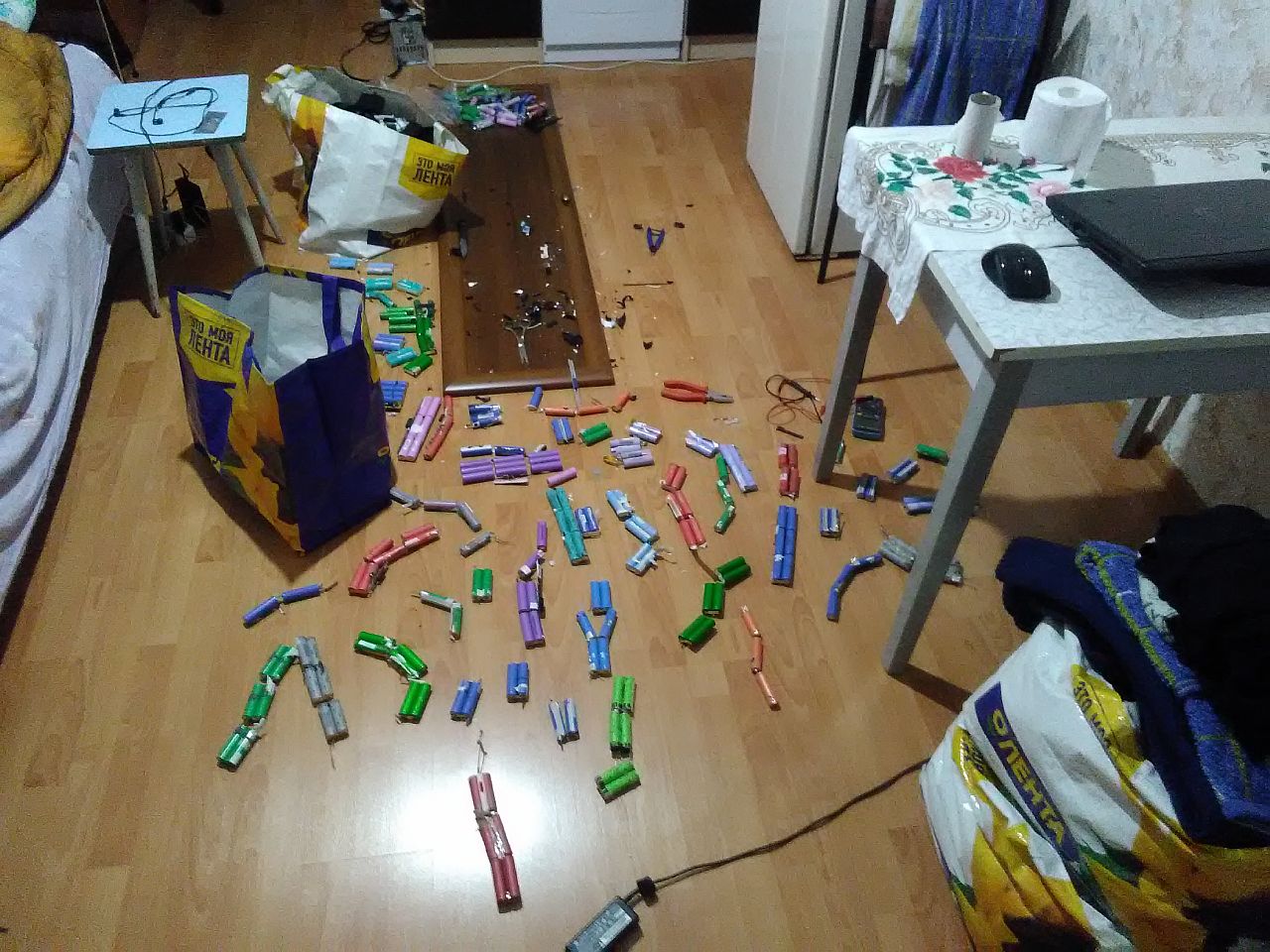For more than 6 years, I have been engaged in the repair and assembly of Li-ion batteries for electric bicycles.
I often find faulty laptop batteries, which are given by computer repair technicians for little money.

So they look after analysis:

I would like to note that most manufacturers make plastic cases in such a way that there is no possibility to open them carefully without breaking it into pieces. The only exceptions are Acer laptop batteries. The top cover can be removed without breaking the latches.
The cells are removed easily, sometimes it happens that the manufacturer adds a lot of sticky glue, which, at times, cannot be cut with a scalpel without damaging the heat shrink of the elements. But these are trifles - insulation is easily restored with adhesive tape.
With the help of simple devices, a capacity test is carried out:

Charge Current - 1A
Discharge Current - 0.5A
The error in measuring the capacitance of this lithocal Li-500 is about plus or minus 2%. Tested on reference cells with known capacitance. To sort the cells by state - these parameters are enough.
I don’t have an opportunity to assess the state of the protection board - the charge-discharge controller (I throw it right away), so we go to the state of the cells.
- Manufacturers in budget laptops most often put cells from Sony, Sanyo, Samsung, Panasonic with a capacity of 2200 mAh, 2600 mAh. Rarely come across 2000 mAh, as well as 2900 mAh, 3100 mAh. All chemistry - cobalt, low current, discharge current according to the passport up to 2C.
The number of cells varies from 4 to 6, occasionally there are tri-cell, 8-9 cell batteries. - Voltage measurements immediately after disassembling the case show that most often the cells are discharged, sometimes very deep (from 2.7V to 0.5V). The laptop controller rejects such batteries, although in order to bring them back to life, it is enough to “push” them a bit by applying a very small charge current - about 0.01A (of course, I know that it is believed that the cell cannot be discharged below 2.75V, since it becomes However, in about half of the cases, an element that has even reached 1.2-1.5V can be restored. The capacity can be up to 95% of the nominal declared. For 6 years of fires or subsequent problems with such restored cells there have never been)
- There are situations when out of 6-8 cells, 4-6 are charged (3.7-3.9V), and two are at zero. This situation is most interesting to me. From practice - branded Japanese and South Korean cells wear out at the same time, without unbalance. In the future, I will describe my assumptions why this could happen.
- Very often, cells sitting at 2.2-2.4 V levels, after pulling out by a small current and the subsequent control cycle, the discharge-charge on the device show excellent parameters: almost full capacity, low internal resistance (not increased for their chemistry), lack of self-discharge. at the same time, it happens that the cells after the analysis show 3.6-3.9V (charge level from 40 to 60%), and after putting them on the charge they start to get very hot and all the current pumped into them translates into heat. They are in the trash.
- The final output of cells that can be reused in lightly loaded assemblies, in flashlights is about 40%. The rest do not pass the test by capacity (less than 80% of the passport), by internal resistance (more than 80 mOhm on DC), by self-discharge (more than 0.002V per day)
Thoughts on why laptop batteries die.
It is well known that the best conditions for long-term storage of Li-ion batteries are a temperature of 5 degrees Celsius and a 40% charge level (3.5-3.6V).
Temperatures above 30 degrees and 100% charge level - the enemy for Li-ion!
batteryuniversity.com/index.php/learn/article/how_to_prolong_lithium_based_batteries

Notebook manufacturers have stipulated that everything be the other way around - a laptop that mostly works on the mains keeps the battery at 100% (4.2, and sometimes 4.35V) and additionally heats it with hot components - a processor, a video card. As a result, the battery dies even without cycling in a year or two due to the acceleration of chemical reactions of electrolyte decomposition and electrode degradation.
In addition, on the discharge-charge controllers, I did not see balancing resistors, as is done on BMS batteries of e-bikes. A cell that is closer to the processor heats up more, it has more self-discharge. An imbalance begins, which nothing can stop. After several cycles, one of the sections goes to “zero”, while the others are still operational.
This leads to the recommendation - immediately after buying a new laptop - to discharge the battery to 40% (not necessarily accurate, you can also 70%, most importantly not 100%) - and put it on a shelf. It is better to make extra charge cycles (this can be done hundreds of times without noticeable wear). Then even after years - it will practically not wear out (tested on more than one personal laptop).
PS Of course, if in your area there is a possibility of a power outage or a laptop is often used autonomously - then this advice will not work. In some cases, the cost of losing information in the event of a power failure can be much more expensive than increased battery wear.